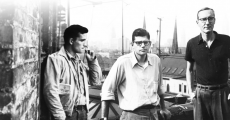
Email: reecejordan98@hotmail.co.uk
Total Article : 168
About Me:18-year-old sixth form student, studying English Literature, History and Government and Politics. My articles will broadly cover topics from the current affairs of politics to reviews of books and albums, as well as adding my own creative pieces, whether it be short fiction or general opinion.

The Beat Generation was a literary, artistic and social movement that came to prominence in 1950s and early 1960s America. The pioneers of the movement, namely Jack Kerouac, Allen Ginsberg and William Borroughs were all writers who, with their idiosyncratic prose style (‘spontaneous prose’ as Kerouac called it), sought to rid of imposed conventions both socially and stylistically.
The ‘beatniks’, as they were named, established a notorious reputation for their hedonistic style of living; they were unapologetic in their indulgence in psychedelic drugs, often using them as a means of creative stimulation; they spat in the face of the growing materialism that had begun spreading through America since the boom of the 1920s, and their accounts of sexual exploits – both heterosexual and homosexual – aroused both dismay and protest. Indeed, Ginsberg’s long zealous poem ‘Howl’ recounts many of the Beats’ escapades around America in searching for spiritual harmony, means of pleasure, and frank detail of sexual intimacy with men. The poem, thus, was used as both an altar of worship in its unrestrained expression, and the epitome of repression in its struggle for publication.
The fundamental group of the Beat Generation – Kerouac, Ginsberg, Burroughs, Lucien Carr and Herbert Huncke, all met in the Columbia University campus in New York in 1944. Their prose style has been largely criticised as being non-academic and formless, and yet its roots came from a direct counterbalance to their professors, Lionel Trilling and Mark Van Doren, whom they believed to perpetuate conventional forms and styles of literature for their own sake. In response, Ginsberg and Carr formulated what they termed a “New Vision”, within which they sought to create a style that replicated the way in which energy-infused life was to be lived. Form and structure, they argued, did not follow life’s unrelenting pace and energy, and thus did not reflect life.
Kerouac, whilst his style derives from the same vein (in interviews and his own autobiographic novels he openly admits to influence from James Joyce, a pioneering modernist writer who was one of many who spearheaded the famous stream of consciousness narrative), it was also born from an attempt to recreate the improvisational freedom of jazz music. Indeed jazz music was near-worshipped by the Beat Generation, and their attitudes towards it create for some of their most famous literature. A jump to the odd chapter in Kerouac’s ‘On the Road’ or ‘Desolation Angels’ will invariably involve a fervent delivery on the transcendence of jazz music, the buzz of a jazz club, or the way in which Dean Moriarty (a protagonist in ‘On the Road’ and pseudonym for Neal Cassady, another member of the Beat Generation) ‘digs it’.
The Beat Generation’s influence did not die with its sole members. The subsequent, more widespread movement, the hippy movement, owed some of its integral principles – anti-war, harmony, appreciation of life and music – to not only an active repellence against the Cold War fear, but also the Beat movement, and even named Ginsberg as one of its forefathers.
Notable works:
‘On the Road’ – Jack Kerouac
‘Howl’ – Allen Ginsberg
‘Junky’ – William Borroughs

0 Comment:
Be the first one to comment on this article.